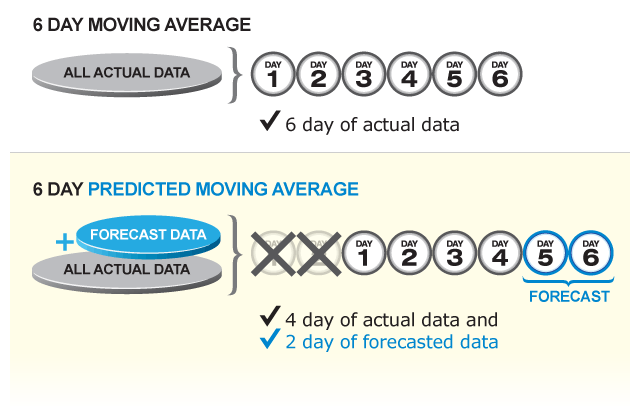
Predicted Moving Averages
Successful traders trade trends, and no trading software is better at predicting short-term trends than VantagePoint Intermarket Analysis Software. Relying on proprietary leading indicators, as opposed to the standard lagging indicators, VantagePoint leads the trading-software industry in trend forecasting.
One of its more important and easy-to-use leading indicators is its set of Predicted Moving Average tools. This set of leading indicators helps find and confirm short-term trend changes, which gives traders the all-important edge needed for success.
Perhaps, traders rely on moving averages alone more than any other tool in technical analysis. As well, moving averages form the basis of many other technical tools. The reason for both is that moving averages smooth out the daily fluctuations in price, which gives traders a more accurate picture of pricing trends.
Unfortunately, though, traditional moving averages rely wholly on past information, which means they lag the market. The problem with moving averages that lag the market is that traders are trading reactively, not proactively. VantagePoint’s Predicted Moving Average tools are leading indicators that proactively anticipate trend changes in the markets, which gives traders an edge.
The reason VantagePoint’s Predicted Moving Average tools lead the market is they utilize neural networks and intermarket analysis to smooth out the price trend. This technologically advanced approach turns what has traditionally been a lagging indicator into a leading indicator, a highly accurate predictor of short-term trends.
Traders like moving averages because they smooth out the peaks and valley in prices, are easy to use, and are easy to interpret. These are the positive qualities. The lagging aspect was always the problem. In 1991, after years of research, Market Technologies developed technology that forecast trends based on moving averages while retaining the positive qualities and reducing, or eliminating, the lag, which is the negative quality. The then newly developed “predicted” moving averages became more powerful than ever imagined. Comparing a traditional moving average with a predicted moving average demonstrates the power of leading indicators, and it shows why VantagePoint is such a popular software tool for successful traders.
A traditional 6-day moving average (MA) of closing prices takes the past six days of closing prices, adds them up, and then divides by six.

All of the data used to calculate the moving average is actual and has already happened. Thus, the predictive value is minimal, based solely on past data.
Conversely, VantagePoint’s Predicted Moving Average (PMA) tools combine actual data and forecast data and then takes an average of those values. Here is an example of a PMA.
A 6-day PMA of closing prices takes the past four days of closes, adds two days of predicted data, and then divides that total by six.

Six days are still averaged, but day five and day six are predicted. This minimizes, if not totally eliminates, the lag. Now, the important key here is that the two days of predicted data derive from the ongoing “under the hood” work of neural networks and intermarket analysis. This technologically advanced combination is the predictive computation that creates a highly accurate differential between the actual, lagging moving average and the leading PMA indicator. Thus, whether the PMA is greater or less than the actual moving average, a trader has a two-day “jump” on the market. VantagePoint’s Predicted Moving Average tools predict trend movement up or down two days in advance. This is an invaluable, technological edge for traders serious about succeeding in today’s technologically competitive market.

These two values which have not happened yet are causing the predicted moving average to be greater in value than the actual moving average indicating that over the next 2 days the market will go up.




